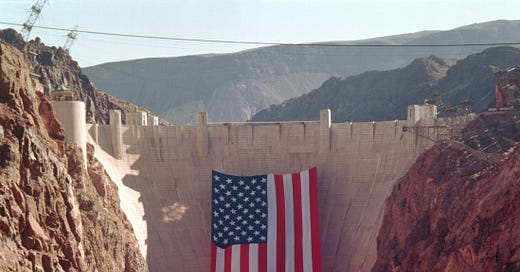TDIH: The Hoover Dam
Hoover emphasized the importance of state intervention. Perhaps other problems can be solved in this same manner, he noted, “rather than the imposition of these problems on the Federal Government."
On this day in 1930, the Secretary of the Interior issues an order: Construction on the Boulder Dam should commence immediately! Today, “Boulder Dam” is better known as the Hoover Dam.
The project had been a long time coming. Twenty-five years earlier, the Colorado River had flooded. There was so much water that an inland sea was accidentally created: the Salton Sea. Needless to say, farms in the area were badly affected. Recovery took two years and more than $3 million.
That’s a lot of money today, but it was even more back then. The cost in today’s dollars would be nearly $100 million.
Unfortunately, the 1905 flood was not the first of its kind. The river could be fairly unpredictable. One Bureau of Reclamation employee observed: “The river was an enemy, and only in short periods of time could you look at it as a useful river. Most of the time it was something that would kill you or ruin your farm.”
Congress took action to help in 1920, perhaps prompted by another flood in 1916.
On May 18, 1920, Congress authorized the Secretary of the Interior to investigate the problem and determine the feasibility of a dam. Nearly two years later, in February 1922, a report was submitted to Congress. The report endorsed the idea of using a dam to simultaneously control the river, even as it provided electricity and water to portions of the West.
Of course, an idea is one thing. Convincing everyone to jump on board is another. Herbert Hoover—the “Great Engineer”—tackled this latter problem.
Hoover was then Secretary of Commerce. He had created a Colorado River Commission to bring the seven affected states together; they could talk about their water rights and possible solutions. (The Commission had already begun its work when Congress received its report in February 1922.) Eventually, Hoover proposed a compromise that enabled these states to reach an agreement, and the Colorado River Compact was signed on November 24, 1922. Later, as President, Hoover signed a proclamation, making the states’ compact effective.
Notably, Hoover emphasized the importance of states working together to solve a problem. Perhaps other problems can be solved in this same manner, he noted, “rather than the imposition of these problems on the Federal Government.”
The dam was named “Hoover Dam” during Hoover’s presidency, but members of FDR’s administration did not think too much of that! They did their best to change the name to “Boulder Dam” after FDR’s election, but the name didn’t stick. Congress eventually restored the name “Hoover Dam,” but not until 1947.
The attached photo shows Hoover Dam with a massive American flag attached to its downstream face. The flag was placed there for a special purpose: The torch for the Summer Olympics traveled across the dam on its way to Atlanta, Georgia, in 1996.
Sources can always be found on my website, here.





The Hoover Dam is an example of how human impact on the environment can take a naturally unsafe environment and make it an unnaturally safe environment for people to live and flourish. A great engineering accomplishment for the benefit of mankind.
🇺🇲